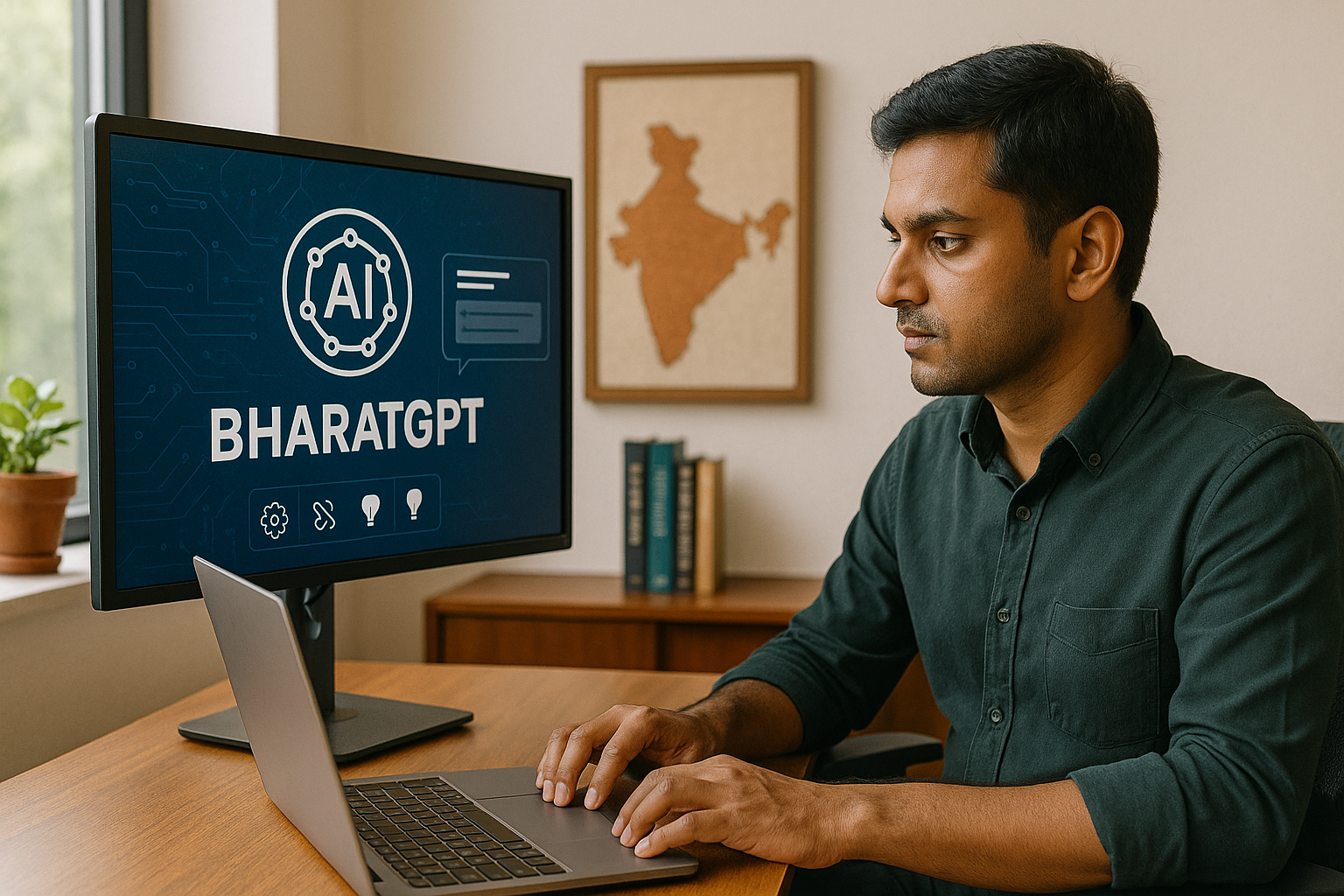Best AI Tool for Indian Users? ChatGPT vs Sarvam AI
As of June 2025, India’s AI landscape is experiencing a remarkable transformation. While global giants like ChatGPT have dominated headlines, a new contender has emerged on the horizon—Sarvam AI, often called “India’s OpenAI.” In a country with 22 official languages and where English proficiency varies widely, the question isn’t just about which AI is more powerful, but which one truly understands India. 🇮🇳
The stakes couldn’t be higher. With the ₹10,000 crore IndiaAI Mission in full swing and indigenous models like BharatGPT supporting 14+ Indian languages for voice and 22 for text, we’re witnessing a battle between global standardization and local specialization. Sarvam AI’s ability to conduct mixed-language conversations at just one rupee per minute is revolutionizing how millions of Indians interact with technology—from banking services to railway bookings. But does this mean ChatGPT’s days are numbered in the subcontinent?
In this comprehensive comparison, we’ll explore the core differences between these AI powerhouses, examine the rise of indigenous alternatives like BharatGPT, and provide practical guidance for Indian users navigating this rapidly evolving landscape. Whether you’re concerned about data sovereignty, language support, or practical applications, this guide will help you determine which AI tool truly deserves your attention in 2025.
Understanding the AI Landscape in India
Understanding the AI Landscape in India
The Rise of Indigenous AI Solutions
The AI ecosystem in India has evolved significantly, developing through a dynamic combination of startups, academic institutions, government initiatives, and multinational corporations. Starting in the late 20th century but gaining real momentum in the 21st century, India now boasts over 1,600 AI startups as of 2023. Companies like Zebra Medical Vision and Niramai are leading innovation in healthcare, while global giants such as Google and Microsoft have established research centers and partnerships throughout the country, contributing to India’s growing AI presence.
Government Initiatives and the IndiaAI Mission
India’s government has taken a proactive approach with the IndiaAI mission, launched in 2023 to foster innovation across various sectors. Unlike other nations where private companies dominate AI advancement, India prioritizes a three-pillar strategy focused on social good. This includes democratizing AI through open innovation, promoting public-sector-led applications, and championing ethical AI governance. Initiatives like the Responsible AI for Social Empowerment (RAISE) program and the Bhashini platform, which integrates Indian languages into AI processing, demonstrate this commitment to inclusive development.
Why India Needs Localized AI Tools
India’s unique socioeconomic challenges across its vast population necessitate specialized AI solutions that address local needs. The current AI tools must navigate India’s linguistic diversity, with platforms like Bhashini supporting multiple Indian languages. Government applications such as the eSanjeevani telemedicine platform address healthcare access disparities, while AI solutions in agriculture like the mKisan portal provide critical information to millions of farmers. These examples highlight why India requires localized AI development rather than simply adopting foreign technologies that may not align with its specific development goals.
With this understanding of India’s unique AI landscape, let’s examine how Sarvam AI is positioning itself as India’s answer to OpenAI, developing solutions specifically designed for Indian contexts and challenges.
Sarvam AI: India’s Answer to OpenAI

Sarvam AI: India’s Answer to OpenAI
Having explored India’s AI landscape, we now turn to Sarvam AI, an indigenous solution emerging as India’s response to global AI giants like OpenAI.
Background and Founding Team Expertise
Founded in 2023 by Vivek Raghavan and Pratyush Kumar, Sarvam AI was established to develop artificial intelligence models that authentically represent India’s linguistic and cultural diversity. Kumar, leveraging his experience as a co-founder of AI4Bharat at IIT Madras, brings crucial expertise to address the limitations of existing AI systems that often neglect Indian languages. The company was recently selected from among 67 applicants by the Indian government to develop the country’s first indigenous large language model (LLM), receiving substantial support including access to 4,000 GPUs for six months as part of the broader IndiaAI Mission.
Voice Capabilities Across Multiple Indian Languages
Sarvam AI’s commitment to India’s linguistic diversity is evident in its development of Sarvam-1, a 2-billion-parameter language model optimized for ten major Indian languages. Trained on a custom dataset of 4 trillion tokens known as Sarvam-2T, this model features a highly efficient tokenizer that reduces tokenization rates compared to existing multilingual models. Additionally, the company has developed Shuka 1.0, an open-source AudioLM designed specifically for accurate voice-to-text conversion in Indian languages, making AI technology more accessible to India’s diverse linguistic population.
Specialized LLM Variants: Sarvam-Large, Sarvam-Small, and Sarvam-Edge
Sarvam AI has developed three distinct LLM variants to address different use cases. Sarvam-Large focuses on advanced reasoning capabilities, while Sarvam-Small is optimized for real-time applications requiring faster processing. Sarvam-Edge is designed for compact on-device tasks, allowing AI processing on smartphones and other edge devices with limited computational resources. All three variants are designed to be fluent in Indian languages and ready for widespread deployment, making them particularly valuable for the Indian market where device capabilities vary widely.
Collaboration with AI4Bharat at IIT Madras
The company’s collaboration with AI4Bharat at IIT Madras has been instrumental in refining its models and addressing the unique challenges posed by India’s linguistic diversity. This partnership has enabled Sarvam AI to develop high-quality datasets and optimize tokenization techniques that ensure both efficiency and cultural relevance in its AI systems. Through strategic partnerships with organizations like Infosys for small language models and the Ministry of Skill Development & Entrepreneurship for AI integration into the Skill India Mission, Sarvam AI exemplifies collaborative innovation while ensuring inclusivity and cultural sensitivity.
Now that we’ve explored Sarvam AI’s foundations and capabilities, let’s examine how it compares to global giant ChatGPT in our next section: “ChatGPT vs Sarvam AI: Core Differences.”
ChatGPT vs Sarvam AI: Core Differences

ChatGPT vs Sarvam AI: Core Differences
Now that we’ve explored how Sarvam AI represents India’s answer to OpenAI, let’s examine the fundamental differences between these platforms. While both utilize advanced language models, Sarvam AI distinguishes itself through its focus on India’s unique linguistic landscape and cultural context.
A. Language support and multilingual capabilities
Sarvam AI has been specifically designed to address India’s linguistic diversity, offering robust support for multiple Indian languages beyond English. Unlike ChatGPT, which primarily excels in English and major global languages, Sarvam AI leverages indigenous data sources to provide more nuanced understanding and generation capabilities for languages like Hindi, Tamil, Telugu, and other regional Indian languages. This multilingual foundation makes Sarvam AI particularly valuable for users who communicate in multiple Indian languages or require content generation in these languages.
B. Voice interaction and mixed-language conversations
A standout feature of Sarvam AI is its advanced voice interaction capabilities optimized for Indian accents and speech patterns. Similar to technologies like Google Cloud’s Speech-to-Text API, Sarvam AI can process voice commands with high accuracy, but with special attention to the nuances of Indian pronunciation and cadence. More impressively, Sarvam AI excels at handling code-switching—the practice of mixing English with Hindi or other Indian languages in the same conversation—which is common in everyday Indian communication but often confuses conventional AI models like ChatGPT.
C. Cultural relevance and localization features
Cultural context represents perhaps the most significant advantage Sarvam AI offers Indian users. While ChatGPT possesses broad knowledge, Sarvam AI demonstrates deeper understanding of Indian cultural references, festivals, historical contexts, and social norms. This cultural intelligence extends to understanding regional idioms, colloquialisms, and contextual nuances that might be lost on global AI models. For businesses targeting Indian consumers, this cultural relevance translates to more authentic engagement and communication that resonates with local audiences.
D. Pricing models and accessibility
Accessibility considerations reveal another key difference between these platforms. Sarvam AI has been developed with a focus on data security, sovereignty, and accessibility for Indian users. Its pricing structure appears designed to accommodate a wider range of Indian businesses and individual users compared to ChatGPT’s subscription model. Additionally, Sarvam AI places emphasis on data sovereignty—keeping Indian data within Indian borders—addressing important regulatory and privacy concerns that are increasingly important to businesses and government entities alike.
With these core differences in mind, next we’ll explore BharatGPT and other indigenous AI contenders that are further expanding India’s AI ecosystem with their own unique approaches and specializations.
BharatGPT and Other Indigenous AI Contenders

BharatGPT and Other Indigenous AI Contenders
A. CoRover.ai’s BharatGPT features and capabilities
Now that we’ve explored the core differences between ChatGPT and Sarvam AI, let’s examine India’s growing ecosystem of indigenous AI solutions. BharatGPT, developed by CoRover.ai, stands as India’s first indigenous generative AI platform supporting 14+ Indian languages for voice and 22 for text interactions. This comprehensive conversational AI suite offers dialogue management, sentiment analysis, and document processing capabilities, making it ideal for government, finance, and education sectors. BharatGPT emphasizes data sovereignty while featuring customizable knowledge bases and integration with ERP/CRM systems, including built-in payment gateways for real-time transactions.
B. Soket AI, Gan.ai, and Gnani.ai: Specialized AI approaches
While BharatGPT provides broad functionality, other indigenous AI platforms offer specialized approaches to meet diverse needs. The platform delivers integrated generative capabilities across text, voice, and video formats, enabling creation and communication across multiple channels. Its commitment to data localization ensures all information remains within Indian borders, addressing critical sovereignty concerns. BharatGPT achieves over 90% accuracy in processing Indian language text data through advanced AI and machine learning technologies, with a scalable design accommodating everything from small research projects to enterprise-level implementations.
C. How these platforms complement the AI ecosystem
These indigenous AI solutions collectively strengthen India’s AI ecosystem by addressing local language needs and ensuring data sovereignty. BharatGPT’s partnership with BHASHNI enhances language translation capabilities, while its collaboration with Google Cloud Platform maintains data privacy and security standards. The platform’s versatility in performing various NLP tasks—from text classification to language translation—makes it applicable across diverse industries. With these foundations in place, let’s examine the practical applications of these AI tools for Indian users.
Practical Applications for Indian Users

Practical Applications for Indian Users
A. Banking and financial services integration
Now that we have explored the indigenous AI contenders in India, let’s examine their practical applications. Financial services in India are experiencing transformative shifts driven by Generative AI, enhancing productivity across the banking sector. According to EY reports, AI tools are enabling significant revenue growth for financial institutions through digital transformation. Vijay Shekhar Sharma, CEO of Paytm, has highlighted AI’s crucial role in making financial services more accessible and efficient for Indian users.
B. Government services and public sector applications
The GPAI Summit 2023 emphasized the need for increased public sector support in AI implementation. Industry leaders advocated for a policy-driven approach to data sharing in AI, which is essential for government services. AI solutions can help overcome existing barriers in public sector applications, with experts calling for deeper penetration of AI technologies across various government departments to serve Indian citizens better.
C. Customer service and business use cases
EY case studies demonstrate how AI is revolutionizing customer service in India, with examples like digital supply chain overhauls resulting in significant business growth. The service sectors are witnessing productivity enhancements through AI-driven innovation. Indian businesses across healthcare, retail, and other industries are positioning themselves as leaders in AI-driven digital transformation to improve customer experiences.
D. Voice-based transactions and payment systems
The pandemic has accelerated the adoption of immersive and affordable online solutions, including voice-based transaction systems. AI chatbots developed in India are revolutionizing accessibility in financial transactions. Platforms like Surabhi demonstrate how AI can connect various aspects of industries, creating integrated payment ecosystems. The success of voice-based AI in India will largely depend on its thoughtful application across diverse sectors.
With these practical applications in mind, next we’ll examine the technical infrastructure and data sovereignty considerations that underpin these AI implementations in India.
Technical Infrastructure and Data Sovereignty

Technical Infrastructure and Data Sovereignty
GPU Resources and Computational Strategies
Now that we’ve explored the practical applications of AI for Indian users, it’s important to understand the infrastructure behind these tools. India faces significant resource limitations in computing power for large-scale AI models, which impacts its integration into global AI supply chains. The emergence of generative AI has heightened the need for substantial computational resources, prompting companies like Google and Reliance Jio to invest in infrastructure that facilitates domestic data management and processing.
Data Privacy and Security Considerations
India’s approach to data security embraces a “restriction strategy” that emphasizes localizing data within Indian territory to ensure data sovereignty. The government has implemented measures requiring both foreign and domestic companies to store data locally, citing concerns over data protection, privacy, foreign surveillance, and national security. The Digital Personal Data Protection Act (DPDPA) establishes Significant Data Fiduciaries (SDFs) who are subject to stricter compliance requirements, though it doesn’t mandate complete data localization.
Hosting Solutions and Partnerships
The National AI Stack represents India’s strategic initiative for achieving digital independence while ensuring ethical AI use. This comprehensive AI infrastructure addresses India’s specific socio-economic and technological contexts through seven critical layers: Strategic Integration, Hardware, Compute, Data, Model, API & Applications, and Security and Compliance. While this push for local infrastructure aims to protect sensitive information and build a robust AI ecosystem, critics argue that effective data handling often requires global cooperation rather than insular policies. With these infrastructure considerations in mind, next we’ll examine the key decision factors for choosing between ChatGPT and Sarvam AI.
Making the Right Choice: Decision Factors

Making the Right Choice: Decision Factors
A. Language requirements and communication preferences
Now that we’ve explored the technical infrastructure and data sovereignty aspects, let’s focus on key decision factors. For Indian users, language capabilities are paramount when choosing between ChatGPT and Sarvam AI. With India’s linguistic diversity, tools like Sarvam AI offer specialized support for Indian languages, making it essential for businesses targeting regional markets. Companies like Ravi’s have prioritized platforms with multilingual support to effectively communicate with diverse customer segments across India.
B. Use case and industry-specific needs
Different industries require specialized AI capabilities. When selecting between ChatGPT and indigenous options like Sarvam AI or BharatGPT, consider your specific application needs. For Indian businesses, adapting AI tools to local consumer behaviors is crucial for maintaining competitiveness. The effectiveness of AI platforms in reducing human workload depends on how well they align with your industry requirements, allowing employees to focus on strategic operations while the AI handles routine tasks.
C. Integration capabilities with existing systems
Seamless integration with your current technology ecosystem is vital for maximizing AI effectiveness. The deployment process typically involves model development, testing, container preparation, and ongoing monitoring. Python-based systems offer various algorithm options like linear regression and decision trees that can potentially reduce the need for multiple tools. When evaluating ChatGPT against Sarvam AI, assess how easily each platform can connect with your existing systems to facilitate rapid deployment and response.
D. Cost considerations and ROI
Financial implications are significant when choosing between global platforms like ChatGPT and indigenous options like Sarvam AI. Consider not just the initial investment but the long-term return on investment. Customized AI solutions may require higher upfront costs but could deliver better results for Indian market conditions. Tools that centralize data management and automate workflows across platforms can improve operational efficiency, potentially offsetting higher costs through improved productivity and enhanced customer experiences in the Indian context.
The Future of AI in India: Finding Your Perfect Match
As we’ve explored throughout this comparison, the AI landscape in India is evolving rapidly with homegrown solutions like Sarvam AI and BharatGPT emerging as serious contenders to global platforms like ChatGPT. The key distinction lies in their focus on India’s linguistic diversity, with support for multiple Indian languages and voice capabilities that make AI accessible to the broader population beyond English speakers. This localization, combined with data sovereignty and cultural relevance, gives indigenous AI solutions a unique advantage for Indian users and businesses.
The choice between ChatGPT and Indian alternatives ultimately depends on your specific needs. If you prioritize language accessibility, data privacy, and solutions tailored to Indian contexts, platforms like Sarvam AI with its affordable voice capabilities (at just one rupee per minute) or BharatGPT with its support for 14+ Indian languages may be your best bet. With the government’s ₹10,000 crore IndiaAI Mission backing these innovations, we’re witnessing the dawn of a new era where AI becomes truly accessible and relevant to all Indians, regardless of their language preferences or technical background. Whether you’re a developer, business owner, or everyday user, the expanding AI ecosystem in India offers more choices than ever before to find the perfect tool for your needs.
Please check Sarvam AI
Please check Chat GPT
Alternat AI tools Please check Remarker AI

